What is sharpness?
Sometimes we are asked by out customers, "How sharp is this blade?"
When we hear this we are always a little confused as to how to respond.
"Sharpness" is not an easy concept to define as there
are many factors to consider. We will now look at some of the issues.
The angle of the cutting edge
Usually, we think of a thin cutting edge like a razor
as very sharp and a thick cutting edge like an axe as not so sharp. This is true. A razor can shave a moustache, but an axe can not.
Therefor we can say that a small angled cutting edge
is sharper than a large angled cutting edge.
By this definition Japanese swords are not very sharp.
Usually their blades are bevel ground with full "meat" on the cutting surface, so the angle of cutting edge is large.
The angle of cutting edge is different on each of these
tools. They are designed for a specific purposes.
A razor is very sharp, but can't cut down a tree. Japanese swords are not
very sharp, because the object being cut is not always a straw man. (=>
Shaping)
How sharp is the edge
A newly purchased razor cuts a moustache well.
If you use the razor everyday, the quality of the cut will decline and
it will need to be sharpened to bring back the edge. The cutting angle
of the razor hasn't change yet, it won't cut well. Irrespective of the
cutting angle, a sharp edge will always out perform a dull one.
On Japanese swords, the cutting edge has to be well sharpened
by a polisher, even though the cutting surface is bevelled and full of
meat.
The hardness of the cutting edge
A sharp edge of a piece of paper can accidentally cut your finger, and however sharp a razor is, it can't cut glass.
The cutting edge has to be harder than the object being
cut.
Edge hardness is a very important factor when it comes to sharpness. What
we can say is that a hard cutting edge can be made sharper than a mild
edge.
A Japanese sword is not a tool for wood carving. A sword
is used on the battle field. Its blade has to attack every part of the
enemy's body including armour and helmets. Therefore toughness in the edge
is as important as hardness.
Hardness can mean brittleness. A cutting edge that is
too hard can sometimes break. A slightly milder cutting edge is tougher
but again, too mild and the edge is weak.
Therefore the hardness of the cutting edge is very important for a blade.
It depends with the quality of the steel and the hardening work (heat treatment).
A Japanese sword can't cut a stone. The cutting edge
is not so hard as a diamond. (An interesting episode "Chinese sword vs Japanese sword")
The shape and the curvature
Most Japanese swords have a curvature and are used with
a swinging action. That is all blades except for tanto and tsurugi.
On such swords, sharpness is not only a matter of the
cutting edge. The shape of the blade also relates to sharpness.
In cases where cutting is by a swinging action, a heavily
curved blade is sharper than a straight blade.
A battle field is not a stage for cutting performances. In battle a sword
is used to parry and to thrust as well as to cut. Because of this, we can't
simply say a deeper curvature makes a better blade.
Conclusion
In the end, we can't give you a simple answer to explain
"sharpness".
Having a sharp edge is one of the many attributes of a good blade. Sharpness
is one of the elements that makes up the cutting power of a blade.
Therefore, what does "sharp" mean?
If we want to know the cutting qualities of a blade without testing it,
we carefully study the blade. Examining swords isn't just for pleasure.
We are also judging its quality. To carefully examine a blade is to understand
a blade. (=> KANTEI)
-Some information about sharpness-
The cutting test in the Edo period
The Edo period was a time of peace. Most of samurais
never knew the battle field, however there were individual fights or duels.
During this period the profession of sword tester was
established to grade blades on their sharpness. They cut criminal's bodies
as tests and inscribe the results onto the blades tang.
The next wakizashi is an example of such a test.

Blade length 58cm


The inscription says, it was tested again and again by
two people, Urano Masanaga and Tomita Yaichizaemon Shigetsuna.
They cut three piled bodies, two piled bodies, and one
body using one hand only. They performed cutting test on various parts
of the bodies. They cut a total of 25 bodies.
Some information about sharpness
(=>A Katana in real fight)
(=> Episode by Kokaji, 14) Experiment of sharpness "Chinese sword vs Japanese sword")
Straw mat cutting
We know people who practice straw mat cutting. They cut
the mats admirably. Everyone is impressed by their skill and their blades
seem very sharp.
I have heard that too long a blade is no good for this
practice. There is an optimum length and an optimum point for these blades
if they are to cut well. It may be similar to a sweet spot of the golf
club.
Their blades are broad and thin, and the cutting surface is flat. Such
slim meat on the edge may be suitable for a blade that is only used for
straw mats. They need a sharp blade.
Unbelievably, they sometimes grind down a good blade
with full meat to get a flat surfaced blade for their practice. It just
means destroying blades. So we can't introduce them as "good" blades. Probably
ordering a special blade from a smith would be better than grinding down
healthy blades.
Their sword should be called "sport instruments" rather
than weapons.
KANTEI (KANTEI game and BUKE-MEKIKI) (This
article is not completed)
The word "KANTEI" means a judgement.
Today, this word is used for a Kantei
game which involves deducing the smith of the blade without seeing
the signature. It also means a Kantei paper
that attributes the smith to an unsigned blades, judges whether the signature
is genuine or fake, and puts a rank on the blade.
This definition of Kantei means learning the characteristics
of the blade and style of the smith.
The Kantei game is a good expedient to study swords, because you can lean
much about the characteristics of blades through it. It is an enjoyable
and interesting game. The system of the game became popular in the Edo
period. But please notice, to get hight score isn't a serious goal in sword
studying. If a man won 100 point at some Kantei game, it doesn't mean he
understands blades. You shouldn't forget the attitude to study the quality
of the blade.
The Kantei paper also became popular in the Edo period.
The most famous family that publishes the paper is the Honnami family.
The papers settle the value of a blade. It changes people's attitude to
a blade but it never change the blade itself.
On the other hand, there is another Kantei style whose
primary function is to study the quality of the blade. This kind of Kantei
has been done from the beginning of sword history.
It is especially called "BUKE-MEKIKI" to distinguish it from
the Kantei game. It means a "Kantei of samurai". Buke is samurai
and Mekiki is the same to Kantei.
It is not a problem that we don't hear the word "Buke-mekiki"
these days, but we should at least try to keep the spirit of it.
The approach is simple. Try to look at the blade with
an honest mind. We study the characteristics that arise from blade quality.
Today, Japanese swords are appreciated as an art form. An aesthetic blade
wins popularity with collectors. We agree with this, however the attractive
patterns on the blade are just glamour. The appearances that arise from
good quality are the blades true beauty.
The Kantei is not only pleasurable for the eyes, but
also pleasurable for the spirit.
Some one said that a good blade is a mirror of your spirit.
If we look back to the masterpieces that the samurai
in old days appreciated. Why did they appreciate such blades?
The quality of the blade. Of course, this includes its cutting power. The
practical considerations were the biggesst factor of blade quality they
appreciated, but no only that. They could see the nature also in the blades.
It didn't mean the arificial patterns designed by the smith.The Japanese sword is not just an art form, and not just
a practical weapon. The way of Kantei is deep and
far reaching.
Please enjoy Kantei games and Kantei papers.
When you remember the Buke-Mekiki, the sword world looks
clear.
(=> How to appreciate blade
quality)
-Some information around the Kantei-
Kantei game
A scene at a Kantei game.
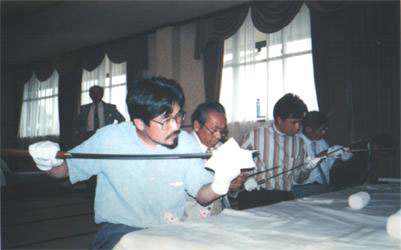
Some blades are put on a table. They are all masterpieces
and the signatures are masked with a hilt.
The people are studying the blades. They try to find every clue to determine
the name of the smith.
Their eyes illustrate how they are crazy for the blades.
A close-up of a student's examination paper. He scores
93 points.
The mark is not important. How he sees the blade is important.
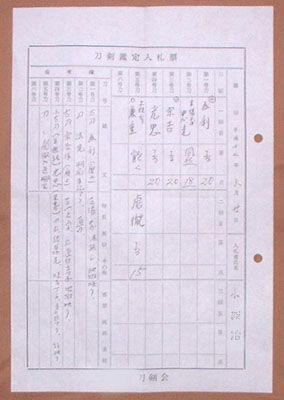
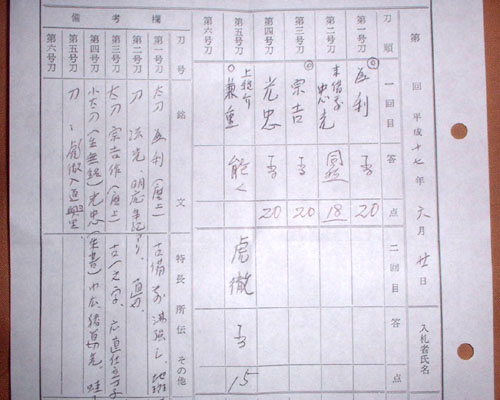
(=> Introduction of Musashino sword club)
Kantei paper
A paper published by NBTHK
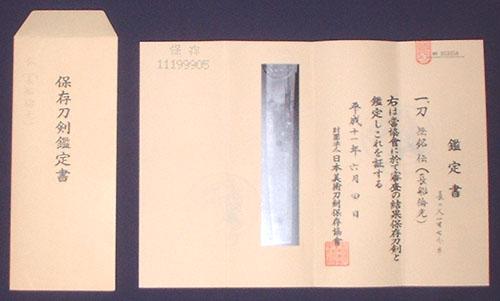
An example of hamon appreciation, Sambon-sugi by Kanemoto
The smith "Kanemoto" is as famous as his Sambonsugi hamon
pattern. This hamon had reputation in the samurai age, but today, it is
not as highly regarded as its pattern is not considered aesthetically pleasing.
Its monotonous, repeated pattern is a little boring.
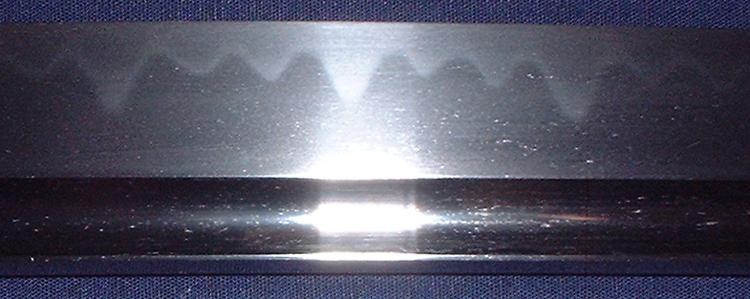
In the samurai age, they didn't appreciate hamon patterns
as much as today. The quality of the hamon was far more important in Buke-mekiki.
They appreciated hamon particles and the brightness of the hamon area.
The sambonsugi hamon by Kanemoto is patterned with neat
line, in other words It is made of even particles. The hamon area is also
fine and has even brightness. It is very beautiful, and it should indicate
good cutting qualities.
There are many historical episodes that demonstrate the
good cutting power of Kanemoto's blades.
When we look at only hamon pattern, we don't see the
full beauty of the hamon.
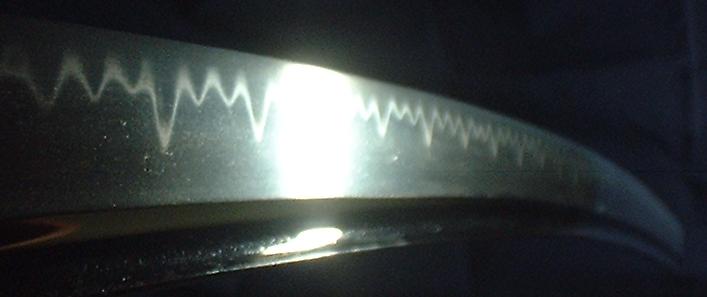
Fortunately, a blade that doesn't have an aesthetic hamon
patterns is not expensive in the current market, so we have a chance ot
find masterpieces at a reasonable price.
Home > Information, Blade > Sharpness, Kantei




